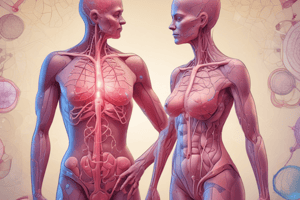Podcast
Questions and Answers
What is the surgical procedure that combines mastectomy and axillary node dissection?
What is the surgical procedure that combines mastectomy and axillary node dissection?
- Radical mastectomy
- Modified radical mastectomy (correct)
- Breast conservation surgery
- Simple mastectomy
What is the median age of a child diagnosed with cancer?
What is the median age of a child diagnosed with cancer?
- 10 years
- 5 years (correct)
- 2 years
- 15 years
What is a sign or symptom that may be suspicious of a diagnosis of leukemia?
What is a sign or symptom that may be suspicious of a diagnosis of leukemia?
- Fatigue
- Headache
- Rash
- All of the above (correct)
What is the next step in the diagnosis of leukemia in a 4-year-old patient like Ashlee?
What is the next step in the diagnosis of leukemia in a 4-year-old patient like Ashlee?
What is a common side effect of treatment for childhood cancer?
What is a common side effect of treatment for childhood cancer?
What is the goal of target therapy in the treatment of leukemia?
What is the goal of target therapy in the treatment of leukemia?
What is a phase of chemotherapy treatment for leukemia?
What is a phase of chemotherapy treatment for leukemia?
Why is cranial radiation used in the treatment of leukemia?
Why is cranial radiation used in the treatment of leukemia?
What is the primary goal of tumor staging and grading?
What is the primary goal of tumor staging and grading?
What is the term for the process by which cancer cells break away from the primary tumor and spread to other parts of the body?
What is the term for the process by which cancer cells break away from the primary tumor and spread to other parts of the body?
What is the term for the decrease in the number of circulating platelets in the blood?
What is the term for the decrease in the number of circulating platelets in the blood?
What is the survival rate of breast cancer?
What is the survival rate of breast cancer?
What is the term for the use of drugs to enhance the effectiveness of the immune system and support cancer treatment?
What is the term for the use of drugs to enhance the effectiveness of the immune system and support cancer treatment?
What type of breast cancer is characterized by cancer cells that remain within the ducts or lobules of the breast?
What type of breast cancer is characterized by cancer cells that remain within the ducts or lobules of the breast?
What is the term for the care of patients with cancer that focuses on relieving symptoms and improving quality of life?
What is the term for the care of patients with cancer that focuses on relieving symptoms and improving quality of life?
What is the primary goal of staging breast cancer tumors?
What is the primary goal of staging breast cancer tumors?
What is the primary goal of the Ontario Breast Screening Program (OBSP)?
What is the primary goal of the Ontario Breast Screening Program (OBSP)?
What is the main difference between Stage I and Stage II breast cancer?
What is the main difference between Stage I and Stage II breast cancer?
What is the term for the process by which cancer cells invade and damage surrounding tissue?
What is the term for the process by which cancer cells invade and damage surrounding tissue?
What is the primary goal of hormonal therapy in breast cancer treatment?
What is the primary goal of hormonal therapy in breast cancer treatment?
What is the term for the hair loss that occurs as a side effect of chemotherapy?
What is the term for the hair loss that occurs as a side effect of chemotherapy?
What is the benefit of targeted therapy in breast cancer treatment?
What is the benefit of targeted therapy in breast cancer treatment?
What is the goal of radiation therapy in breast cancer treatment?
What is the goal of radiation therapy in breast cancer treatment?
What is the primary goal of surgery in breast cancer treatment?
What is the primary goal of surgery in breast cancer treatment?
What is the primary purpose of the intensification phase in leukemia treatment?
What is the primary purpose of the intensification phase in leukemia treatment?
What is a life-threatening complication that can occur during the start of cancer treatment?
What is a life-threatening complication that can occur during the start of cancer treatment?
What is the primary goal of maintenance phase in leukemia treatment?
What is the primary goal of maintenance phase in leukemia treatment?
What should parents be taught to notify the oncologist about ASAP?
What should parents be taught to notify the oncologist about ASAP?
What is the primary cause of renal failure in patients with tumor lysis syndrome?
What is the primary cause of renal failure in patients with tumor lysis syndrome?
What is the primary goal of CNS prophylaxis in leukemia treatment?
What is the primary goal of CNS prophylaxis in leukemia treatment?
What is the primary medication used to treat nausea and vomiting in patients with leukemia?
What is the primary medication used to treat nausea and vomiting in patients with leukemia?
What is the primary reason for using central venous access devices in patients with leukemia?
What is the primary reason for using central venous access devices in patients with leukemia?
What is the primary reason why osteoporosis is referred to as the 'silent thief'?
What is the primary reason why osteoporosis is referred to as the 'silent thief'?
What is a major risk factor for fracture in osteoporosis?
What is a major risk factor for fracture in osteoporosis?
What is the primary goal of discharge teaching for patients with osteoporosis?
What is the primary goal of discharge teaching for patients with osteoporosis?
Which of the following is a true statement about osteoporosis management?
Which of the following is a true statement about osteoporosis management?
What is the primary difference between primary and secondary osteoporosis?
What is the primary difference between primary and secondary osteoporosis?
Which of the following joints is most at risk for fracture in osteoporosis?
Which of the following joints is most at risk for fracture in osteoporosis?
What is the primary goal of menopause care and treatment?
What is the primary goal of menopause care and treatment?
What is the primary reason why bisphosphonate medication is taken after an osteoporosis diagnosis?
What is the primary reason why bisphosphonate medication is taken after an osteoporosis diagnosis?
Flashcards are hidden until you start studying
Study Notes
Cancer: A Group of Distinct Diseases
- Cancer is a group of distinct diseases characterized by uncontrolled growth and spread of abnormal cells.
- Cancer etiology involves multiple factors, including genetic mutations, environmental exposures, and lifestyle choices.
The Process of Carcinogenesis
- The process of carcinogenesis consists of three major steps: initiation, promotion, and progression.
- Initiation involves genetic mutations that lead to the formation of cancer cells.
- Promotion involves the growth and proliferation of initiated cancer cells.
- Progression involves the spread of cancer cells to other parts of the body.
Early Warning Signs of Cancer
- Early warning signs of cancer include:
- C: Change in bowel or bladder habits
- A: A lesion that does not heal
- U: Unusual bleeding
- T: Thickening or lump
- I: Indigestion or trouble swallowing
- O: Obvious change in wart or mole
- N: Nagging cough or persistent hoarseness
Benign vs. Malignant Tumors
- Benign tumors are non-cancerous and do not invade surrounding tissues or spread to other parts of the body.
- Malignant tumors are cancerous and can invade surrounding tissues and spread to other parts of the body.
Cancer Spread and Metastasis
- Cancer can spread through three main mechanisms: invasion, metastasis, and angiogenesis.
- Invasion involves the direct growth of cancer cells into surrounding tissues.
- Metastasis involves the spread of cancer cells to distant parts of the body through the bloodstream or lymphatic system.
- Angiogenesis involves the formation of new blood vessels to supply cancer cells with oxygen and nutrients.
Tumor Staging and Grading
- Tumor staging involves the classification of cancer based on the extent of the tumor and its spread to other parts of the body.
- Tumor grading involves the classification of cancer based on the aggressiveness of the tumor cells.
- High-grade tumors are more aggressive and have a poorer prognosis.
Treatment Goals and Options
- Treatment goals for cancer include cure, control, and palliation.
- Treatment options for cancer include surgery, radiation therapy, chemotherapy, hormone therapy, and targeted therapy.
- Treatment plans are individualized based on the type of cancer, stage, and grade of the tumor.
Cancer Management and Nursing Care
- Cancer management involves a multidisciplinary approach, including medical, surgical, and radiation oncology, as well as nursing care.
- Nursing care for cancer patients involves managing symptoms, supporting patients and their families, and providing education and guidance.
Breast Cancer
- Breast cancer is the most common cancer in women, and early detection is key to better survival rates.
- Risk factors for breast cancer include family history, genetic mutations, and hormonal factors.
- Screening programs for breast cancer include mammography, clinical breast exams, and breast self-exams.
Childhood Cancer
- Childhood cancer is a leading cause of death in children, and leukemia is the most common type of childhood cancer.
- Leukemia is cancer of the blood and bone marrow, and symptoms include fatigue, bleeding, and infection.
- Treatment options for childhood cancer include chemotherapy, radiation therapy, and bone marrow transplantation.
Menopause and Osteoporosis
- Menopause is a natural biological process that occurs in women, characterized by the cessation of menstruation.
- Osteoporosis is a silent disease that leads to brittle and porous bones, increasing the risk of fractures.
- Risk factors for osteoporosis include age, gender, genetic factors, and certain medical conditions.
- Treatment options for osteoporosis include medications, hormone therapy, and lifestyle changes.
Studying That Suits You
Use AI to generate personalized quizzes and flashcards to suit your learning preferences.



